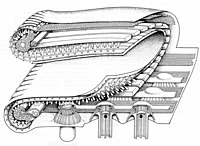Stephanopogon
Stephanopogon closely resembles certain ciliates and was originally classified with them (,[1] but is now considered related to heterolobosean flagellates.The cell is somewhat flattened, with multiple smooth flagella arranged in rows running from the front to the back, and has an anterior mouth supported by rods.Because nuclear dimorphism is absent, Stephanopogon had been regarded as an evolutionary intermediate between the ciliates and other protozoa, and possibly an ancestor of the animals as well.Corliss and Lipscomb showed that it is not cytologically similar to ciliates, lacking their complex pellicle and infraciliature.The bases of the flagella in both genera are attached to an electron dense cytoskeletal material,[5] but it has been argued that this is not an apomorphy of the clade [6] It has recently been included as a heterolosean in the class Percolatea, along with Percolomonas.

Scientific classificationEukaryotaExcavataPercolozoaPercolateaType speciesprotistciliatesflagellatesbacteriadiatomsnucleimacronucleimicronucleinuclear dimorphismPercolomonasDomainDiaphoretickesAmorpheaDiscobaJakobeaJakobidaAndaluciidaeHistionidaeJakobidaeStygiellidaeTsukubeaTsukubamonadidaTsukubamonadidaeDiscicristataNeovahlkampfiidaeGruberellidaeHeteroloboseaAcrasidaAcrasidaeNaegleriidaVahlkampfiidaePercolomonadidaStephanopogonidaeEuglenozoaPostgaardiaPostgaardeaPostgaardidaCalkinsiidaePostgaardidaeGlycomonadaDiplonemeaDiplonemidaDiplonemidaeKinetoplasteaBodonidaBodonidaeTrypanosomatidaTrypanosomatidaeEuglenidaHemioliaLiburnaAnisonemidaAnisonemidaeNeometanemidaePeranemataceaeEuglenophyceaeRapazidaeEutreptiaceaeEuglenalesEuglenaceaeLoukozoaNeoloukaMalawimonadeaMalawimonadidaImasidaeMalawimonadidaeAncyromonadidaMetamonadaAnaeromonadaAnaeromonadeaTrimastigidaeOxymonadidaTrichozoaAnaeramoebidaeFornicataCarpediemonadeaCarpediemonadidaCarpediemonadidaeDiplomonadidaDysnectidaeRetortamonadidaChilomastigidaeRetortamonadidaeParabasaliaTrichomonadidaTrichomonadidaeTrichonymphidaWikidataWikispeciesOpen Tree of Life